ACCY801 Report: In-depth Financial Analysis of BAP and KMD Companies
VerifiedAdded on 2022/09/15
|15
|3833
|15
Report
AI Summary
This report provides a comprehensive financial analysis of Bapcor (BAP) and Kathmandu Holdings Limited (KMD), comparing their performance based on 2019 annual reports. The analysis includes calculations and comparisons of various financial ratios, such as current and quick ratios for liquidity, ...
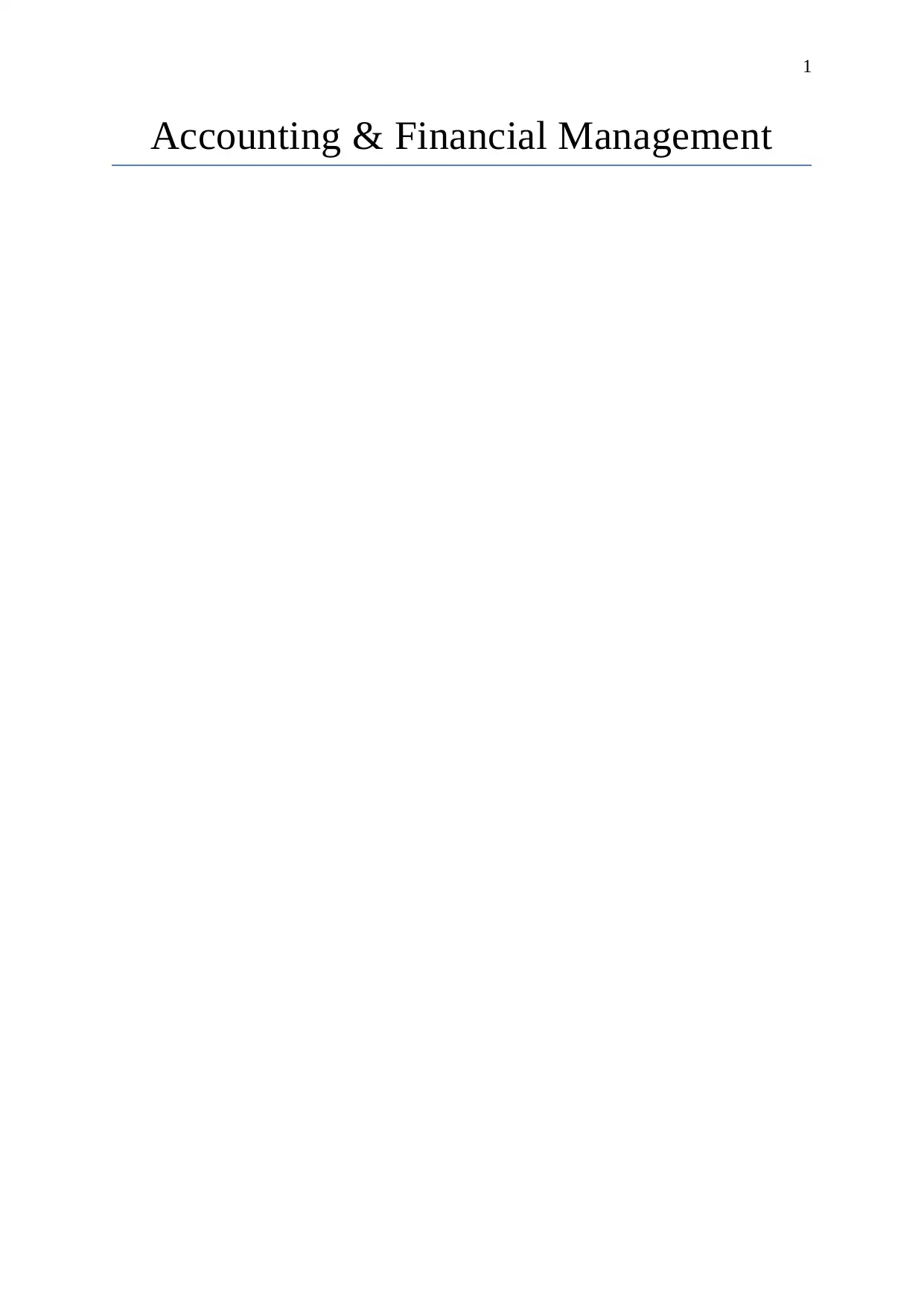
1
Accounting & Financial Management
Accounting & Financial Management
Paraphrase This Document
Need a fresh take? Get an instant paraphrase of this document with our AI Paraphraser
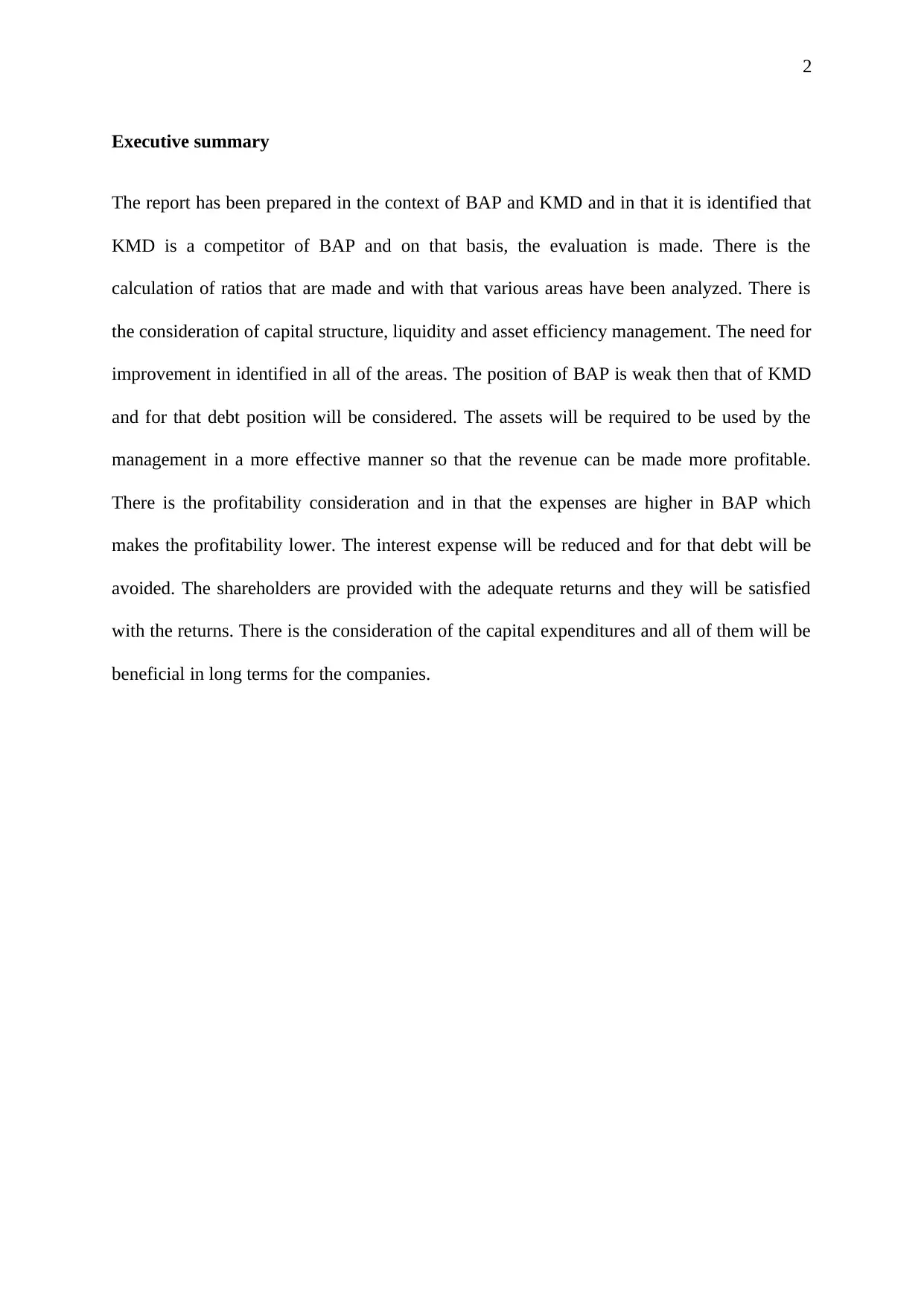
2
Executive summary
The report has been prepared in the context of BAP and KMD and in that it is identified that
KMD is a competitor of BAP and on that basis, the evaluation is made. There is the
calculation of ratios that are made and with that various areas have been analyzed. There is
the consideration of capital structure, liquidity and asset efficiency management. The need for
improvement in identified in all of the areas. The position of BAP is weak then that of KMD
and for that debt position will be considered. The assets will be required to be used by the
management in a more effective manner so that the revenue can be made more profitable.
There is the profitability consideration and in that the expenses are higher in BAP which
makes the profitability lower. The interest expense will be reduced and for that debt will be
avoided. The shareholders are provided with the adequate returns and they will be satisfied
with the returns. There is the consideration of the capital expenditures and all of them will be
beneficial in long terms for the companies.
Executive summary
The report has been prepared in the context of BAP and KMD and in that it is identified that
KMD is a competitor of BAP and on that basis, the evaluation is made. There is the
calculation of ratios that are made and with that various areas have been analyzed. There is
the consideration of capital structure, liquidity and asset efficiency management. The need for
improvement in identified in all of the areas. The position of BAP is weak then that of KMD
and for that debt position will be considered. The assets will be required to be used by the
management in a more effective manner so that the revenue can be made more profitable.
There is the profitability consideration and in that the expenses are higher in BAP which
makes the profitability lower. The interest expense will be reduced and for that debt will be
avoided. The shareholders are provided with the adequate returns and they will be satisfied
with the returns. There is the consideration of the capital expenditures and all of them will be
beneficial in long terms for the companies.
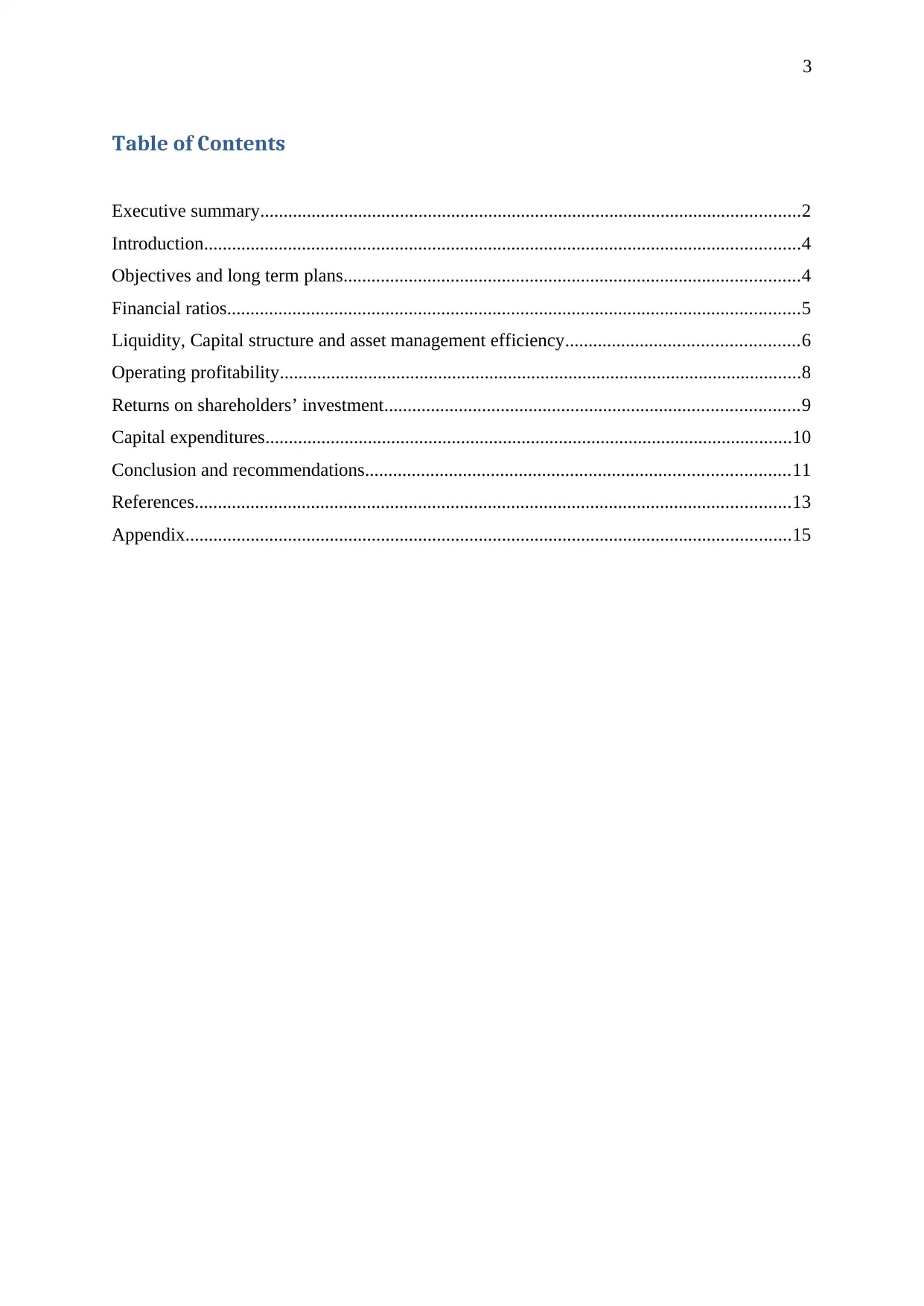
3
Table of Contents
Executive summary....................................................................................................................2
Introduction................................................................................................................................4
Objectives and long term plans..................................................................................................4
Financial ratios...........................................................................................................................5
Liquidity, Capital structure and asset management efficiency..................................................6
Operating profitability................................................................................................................8
Returns on shareholders’ investment.........................................................................................9
Capital expenditures.................................................................................................................10
Conclusion and recommendations...........................................................................................11
References................................................................................................................................13
Appendix..................................................................................................................................15
Table of Contents
Executive summary....................................................................................................................2
Introduction................................................................................................................................4
Objectives and long term plans..................................................................................................4
Financial ratios...........................................................................................................................5
Liquidity, Capital structure and asset management efficiency..................................................6
Operating profitability................................................................................................................8
Returns on shareholders’ investment.........................................................................................9
Capital expenditures.................................................................................................................10
Conclusion and recommendations...........................................................................................11
References................................................................................................................................13
Appendix..................................................................................................................................15
⊘ This is a preview!⊘
Do you want full access?
Subscribe today to unlock all pages.

Trusted by 1+ million students worldwide
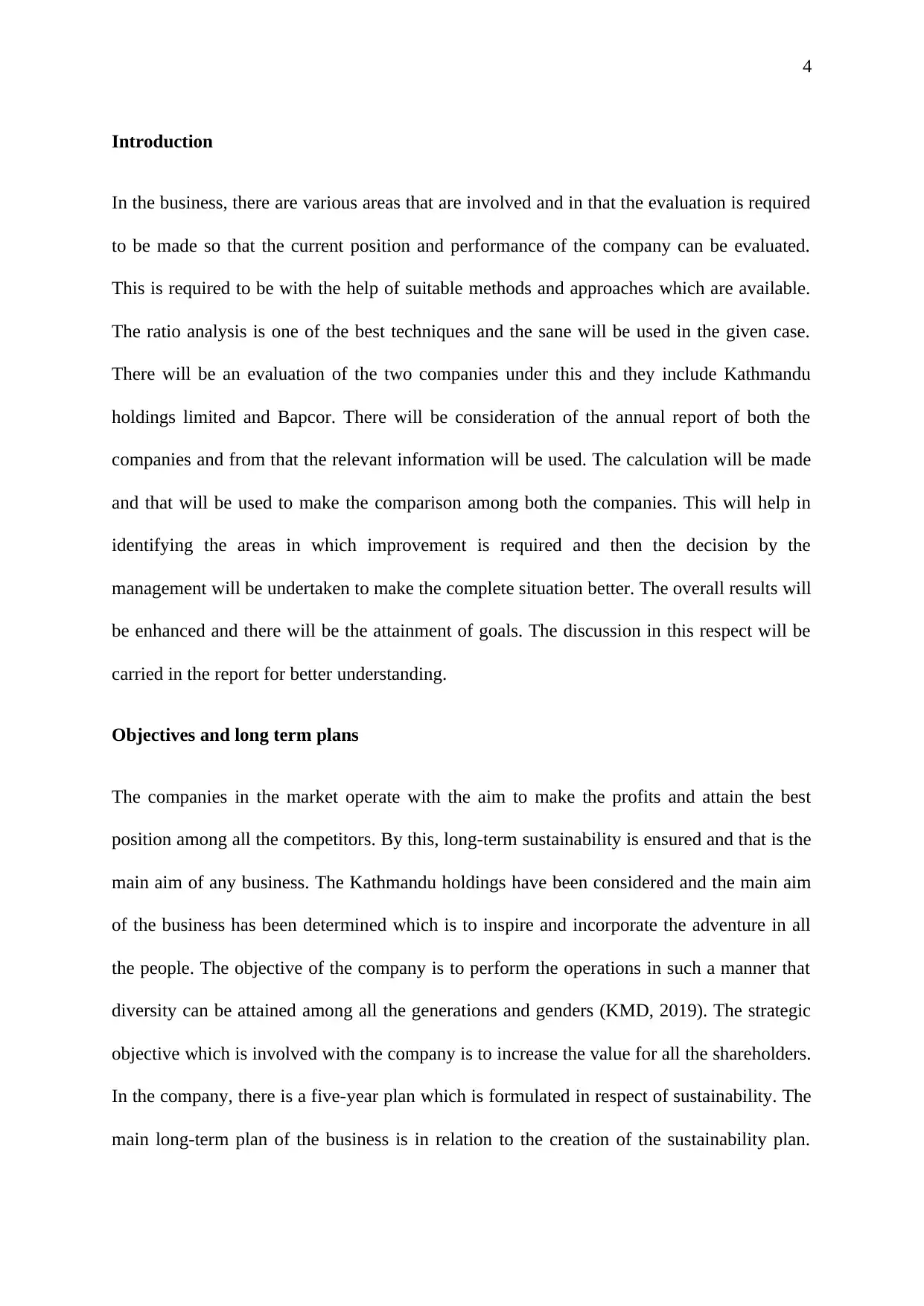
4
Introduction
In the business, there are various areas that are involved and in that the evaluation is required
to be made so that the current position and performance of the company can be evaluated.
This is required to be with the help of suitable methods and approaches which are available.
The ratio analysis is one of the best techniques and the sane will be used in the given case.
There will be an evaluation of the two companies under this and they include Kathmandu
holdings limited and Bapcor. There will be consideration of the annual report of both the
companies and from that the relevant information will be used. The calculation will be made
and that will be used to make the comparison among both the companies. This will help in
identifying the areas in which improvement is required and then the decision by the
management will be undertaken to make the complete situation better. The overall results will
be enhanced and there will be the attainment of goals. The discussion in this respect will be
carried in the report for better understanding.
Objectives and long term plans
The companies in the market operate with the aim to make the profits and attain the best
position among all the competitors. By this, long-term sustainability is ensured and that is the
main aim of any business. The Kathmandu holdings have been considered and the main aim
of the business has been determined which is to inspire and incorporate the adventure in all
the people. The objective of the company is to perform the operations in such a manner that
diversity can be attained among all the generations and genders (KMD, 2019). The strategic
objective which is involved with the company is to increase the value for all the shareholders.
In the company, there is a five-year plan which is formulated in respect of sustainability. The
main long-term plan of the business is in relation to the creation of the sustainability plan.
Introduction
In the business, there are various areas that are involved and in that the evaluation is required
to be made so that the current position and performance of the company can be evaluated.
This is required to be with the help of suitable methods and approaches which are available.
The ratio analysis is one of the best techniques and the sane will be used in the given case.
There will be an evaluation of the two companies under this and they include Kathmandu
holdings limited and Bapcor. There will be consideration of the annual report of both the
companies and from that the relevant information will be used. The calculation will be made
and that will be used to make the comparison among both the companies. This will help in
identifying the areas in which improvement is required and then the decision by the
management will be undertaken to make the complete situation better. The overall results will
be enhanced and there will be the attainment of goals. The discussion in this respect will be
carried in the report for better understanding.
Objectives and long term plans
The companies in the market operate with the aim to make the profits and attain the best
position among all the competitors. By this, long-term sustainability is ensured and that is the
main aim of any business. The Kathmandu holdings have been considered and the main aim
of the business has been determined which is to inspire and incorporate the adventure in all
the people. The objective of the company is to perform the operations in such a manner that
diversity can be attained among all the generations and genders (KMD, 2019). The strategic
objective which is involved with the company is to increase the value for all the shareholders.
In the company, there is a five-year plan which is formulated in respect of sustainability. The
main long-term plan of the business is in relation to the creation of the sustainability plan.
Paraphrase This Document
Need a fresh take? Get an instant paraphrase of this document with our AI Paraphraser
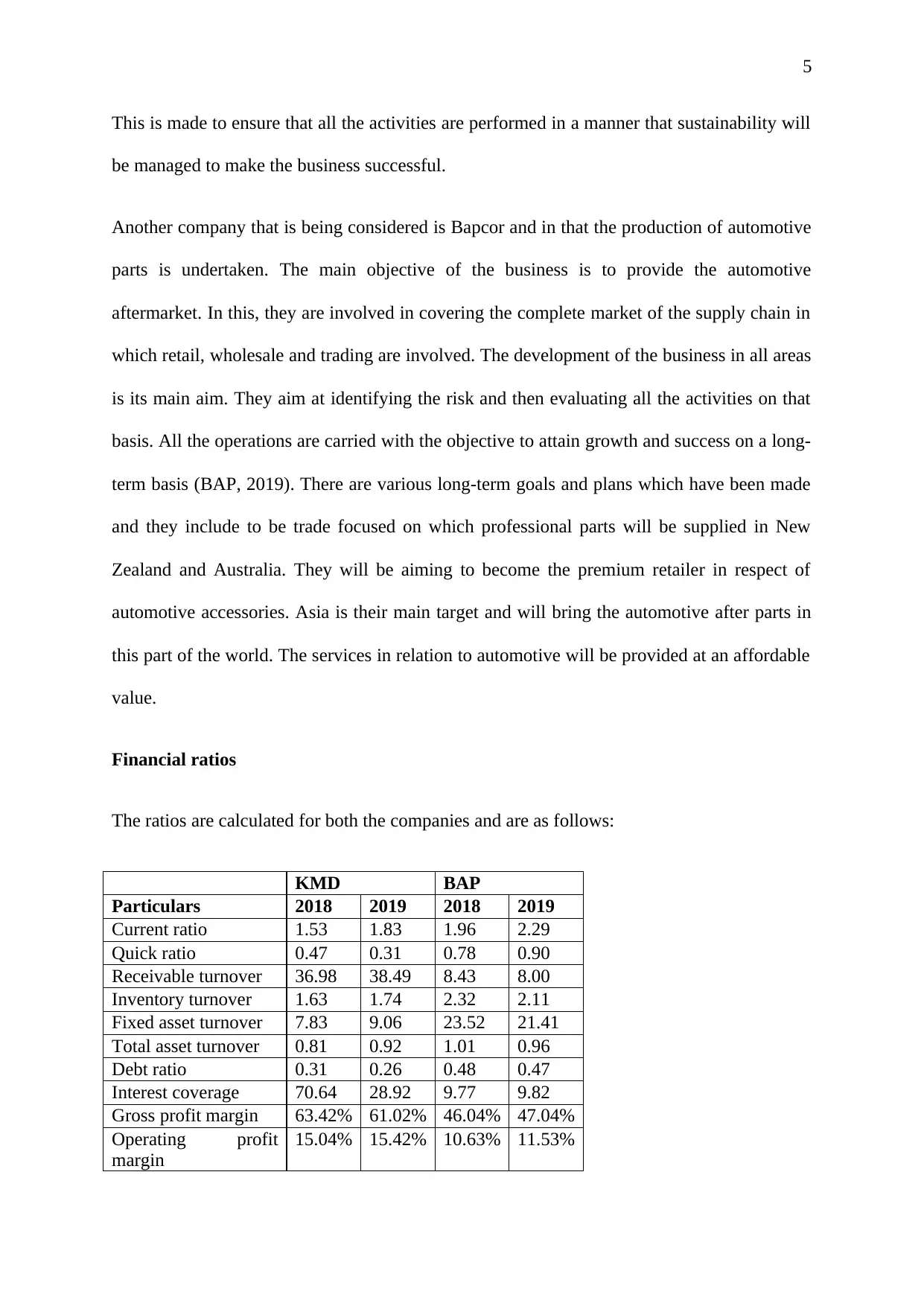
5
This is made to ensure that all the activities are performed in a manner that sustainability will
be managed to make the business successful.
Another company that is being considered is Bapcor and in that the production of automotive
parts is undertaken. The main objective of the business is to provide the automotive
aftermarket. In this, they are involved in covering the complete market of the supply chain in
which retail, wholesale and trading are involved. The development of the business in all areas
is its main aim. They aim at identifying the risk and then evaluating all the activities on that
basis. All the operations are carried with the objective to attain growth and success on a long-
term basis (BAP, 2019). There are various long-term goals and plans which have been made
and they include to be trade focused on which professional parts will be supplied in New
Zealand and Australia. They will be aiming to become the premium retailer in respect of
automotive accessories. Asia is their main target and will bring the automotive after parts in
this part of the world. The services in relation to automotive will be provided at an affordable
value.
Financial ratios
The ratios are calculated for both the companies and are as follows:
KMD BAP
Particulars 2018 2019 2018 2019
Current ratio 1.53 1.83 1.96 2.29
Quick ratio 0.47 0.31 0.78 0.90
Receivable turnover 36.98 38.49 8.43 8.00
Inventory turnover 1.63 1.74 2.32 2.11
Fixed asset turnover 7.83 9.06 23.52 21.41
Total asset turnover 0.81 0.92 1.01 0.96
Debt ratio 0.31 0.26 0.48 0.47
Interest coverage 70.64 28.92 9.77 9.82
Gross profit margin 63.42% 61.02% 46.04% 47.04%
Operating profit
margin
15.04% 15.42% 10.63% 11.53%
This is made to ensure that all the activities are performed in a manner that sustainability will
be managed to make the business successful.
Another company that is being considered is Bapcor and in that the production of automotive
parts is undertaken. The main objective of the business is to provide the automotive
aftermarket. In this, they are involved in covering the complete market of the supply chain in
which retail, wholesale and trading are involved. The development of the business in all areas
is its main aim. They aim at identifying the risk and then evaluating all the activities on that
basis. All the operations are carried with the objective to attain growth and success on a long-
term basis (BAP, 2019). There are various long-term goals and plans which have been made
and they include to be trade focused on which professional parts will be supplied in New
Zealand and Australia. They will be aiming to become the premium retailer in respect of
automotive accessories. Asia is their main target and will bring the automotive after parts in
this part of the world. The services in relation to automotive will be provided at an affordable
value.
Financial ratios
The ratios are calculated for both the companies and are as follows:
KMD BAP
Particulars 2018 2019 2018 2019
Current ratio 1.53 1.83 1.96 2.29
Quick ratio 0.47 0.31 0.78 0.90
Receivable turnover 36.98 38.49 8.43 8.00
Inventory turnover 1.63 1.74 2.32 2.11
Fixed asset turnover 7.83 9.06 23.52 21.41
Total asset turnover 0.81 0.92 1.01 0.96
Debt ratio 0.31 0.26 0.48 0.47
Interest coverage 70.64 28.92 9.77 9.82
Gross profit margin 63.42% 61.02% 46.04% 47.04%
Operating profit
margin
15.04% 15.42% 10.63% 11.53%
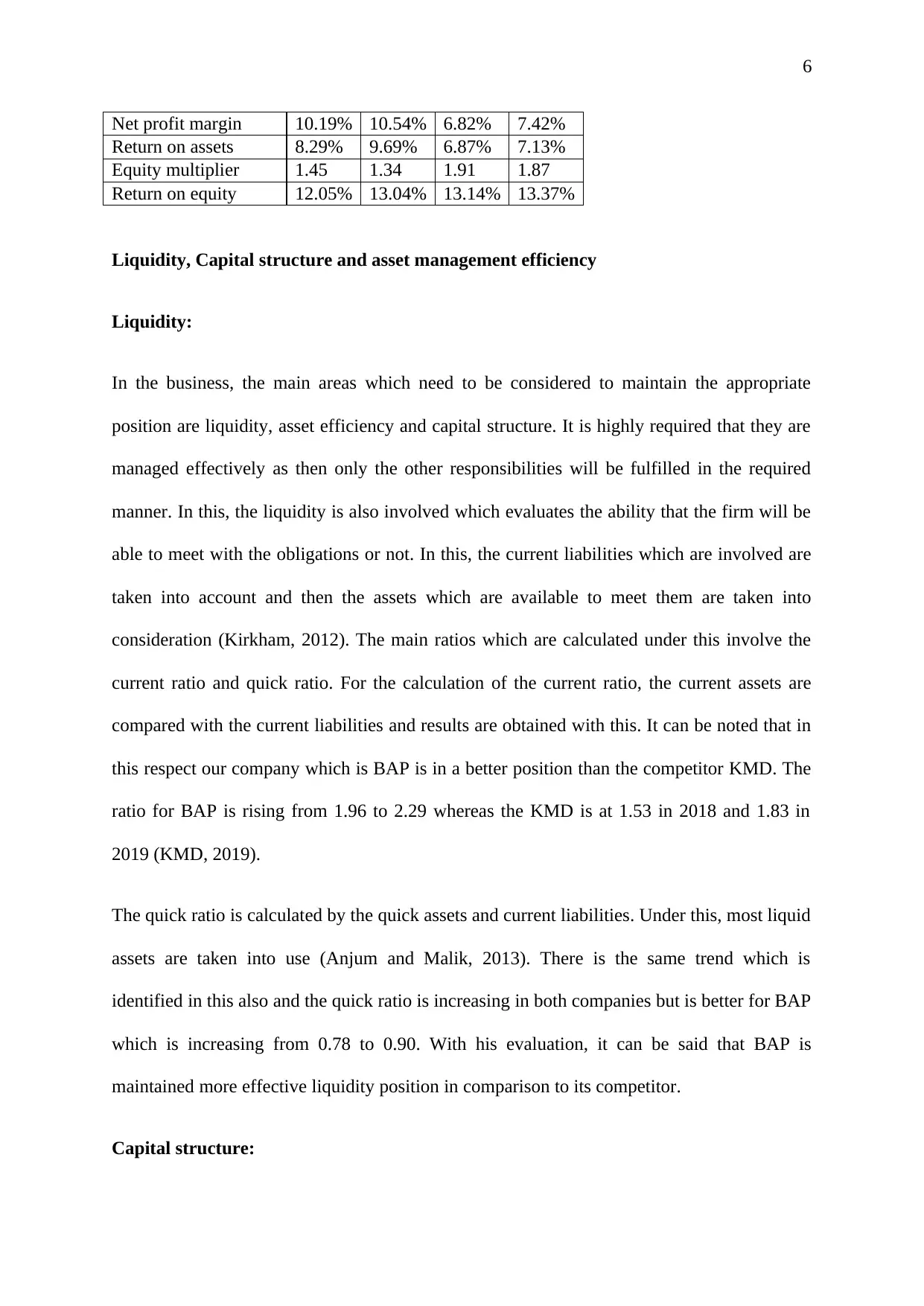
6
Net profit margin 10.19% 10.54% 6.82% 7.42%
Return on assets 8.29% 9.69% 6.87% 7.13%
Equity multiplier 1.45 1.34 1.91 1.87
Return on equity 12.05% 13.04% 13.14% 13.37%
Liquidity, Capital structure and asset management efficiency
Liquidity:
In the business, the main areas which need to be considered to maintain the appropriate
position are liquidity, asset efficiency and capital structure. It is highly required that they are
managed effectively as then only the other responsibilities will be fulfilled in the required
manner. In this, the liquidity is also involved which evaluates the ability that the firm will be
able to meet with the obligations or not. In this, the current liabilities which are involved are
taken into account and then the assets which are available to meet them are taken into
consideration (Kirkham, 2012). The main ratios which are calculated under this involve the
current ratio and quick ratio. For the calculation of the current ratio, the current assets are
compared with the current liabilities and results are obtained with this. It can be noted that in
this respect our company which is BAP is in a better position than the competitor KMD. The
ratio for BAP is rising from 1.96 to 2.29 whereas the KMD is at 1.53 in 2018 and 1.83 in
2019 (KMD, 2019).
The quick ratio is calculated by the quick assets and current liabilities. Under this, most liquid
assets are taken into use (Anjum and Malik, 2013). There is the same trend which is
identified in this also and the quick ratio is increasing in both companies but is better for BAP
which is increasing from 0.78 to 0.90. With his evaluation, it can be said that BAP is
maintained more effective liquidity position in comparison to its competitor.
Capital structure:
Net profit margin 10.19% 10.54% 6.82% 7.42%
Return on assets 8.29% 9.69% 6.87% 7.13%
Equity multiplier 1.45 1.34 1.91 1.87
Return on equity 12.05% 13.04% 13.14% 13.37%
Liquidity, Capital structure and asset management efficiency
Liquidity:
In the business, the main areas which need to be considered to maintain the appropriate
position are liquidity, asset efficiency and capital structure. It is highly required that they are
managed effectively as then only the other responsibilities will be fulfilled in the required
manner. In this, the liquidity is also involved which evaluates the ability that the firm will be
able to meet with the obligations or not. In this, the current liabilities which are involved are
taken into account and then the assets which are available to meet them are taken into
consideration (Kirkham, 2012). The main ratios which are calculated under this involve the
current ratio and quick ratio. For the calculation of the current ratio, the current assets are
compared with the current liabilities and results are obtained with this. It can be noted that in
this respect our company which is BAP is in a better position than the competitor KMD. The
ratio for BAP is rising from 1.96 to 2.29 whereas the KMD is at 1.53 in 2018 and 1.83 in
2019 (KMD, 2019).
The quick ratio is calculated by the quick assets and current liabilities. Under this, most liquid
assets are taken into use (Anjum and Malik, 2013). There is the same trend which is
identified in this also and the quick ratio is increasing in both companies but is better for BAP
which is increasing from 0.78 to 0.90. With his evaluation, it can be said that BAP is
maintained more effective liquidity position in comparison to its competitor.
Capital structure:
⊘ This is a preview!⊘
Do you want full access?
Subscribe today to unlock all pages.

Trusted by 1+ million students worldwide
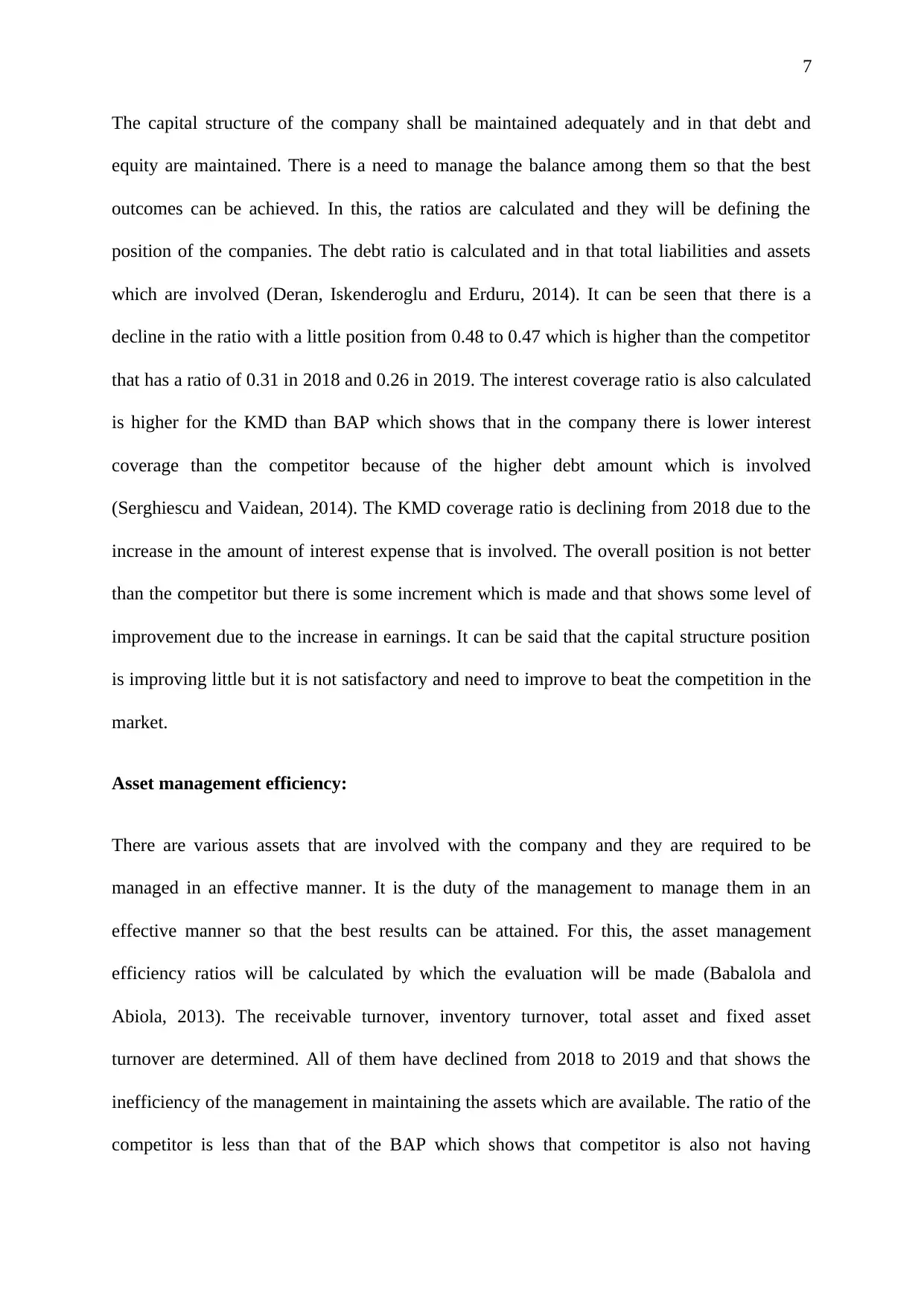
7
The capital structure of the company shall be maintained adequately and in that debt and
equity are maintained. There is a need to manage the balance among them so that the best
outcomes can be achieved. In this, the ratios are calculated and they will be defining the
position of the companies. The debt ratio is calculated and in that total liabilities and assets
which are involved (Deran, Iskenderoglu and Erduru, 2014). It can be seen that there is a
decline in the ratio with a little position from 0.48 to 0.47 which is higher than the competitor
that has a ratio of 0.31 in 2018 and 0.26 in 2019. The interest coverage ratio is also calculated
is higher for the KMD than BAP which shows that in the company there is lower interest
coverage than the competitor because of the higher debt amount which is involved
(Serghiescu and Vaidean, 2014). The KMD coverage ratio is declining from 2018 due to the
increase in the amount of interest expense that is involved. The overall position is not better
than the competitor but there is some increment which is made and that shows some level of
improvement due to the increase in earnings. It can be said that the capital structure position
is improving little but it is not satisfactory and need to improve to beat the competition in the
market.
Asset management efficiency:
There are various assets that are involved with the company and they are required to be
managed in an effective manner. It is the duty of the management to manage them in an
effective manner so that the best results can be attained. For this, the asset management
efficiency ratios will be calculated by which the evaluation will be made (Babalola and
Abiola, 2013). The receivable turnover, inventory turnover, total asset and fixed asset
turnover are determined. All of them have declined from 2018 to 2019 and that shows the
inefficiency of the management in maintaining the assets which are available. The ratio of the
competitor is less than that of the BAP which shows that competitor is also not having
The capital structure of the company shall be maintained adequately and in that debt and
equity are maintained. There is a need to manage the balance among them so that the best
outcomes can be achieved. In this, the ratios are calculated and they will be defining the
position of the companies. The debt ratio is calculated and in that total liabilities and assets
which are involved (Deran, Iskenderoglu and Erduru, 2014). It can be seen that there is a
decline in the ratio with a little position from 0.48 to 0.47 which is higher than the competitor
that has a ratio of 0.31 in 2018 and 0.26 in 2019. The interest coverage ratio is also calculated
is higher for the KMD than BAP which shows that in the company there is lower interest
coverage than the competitor because of the higher debt amount which is involved
(Serghiescu and Vaidean, 2014). The KMD coverage ratio is declining from 2018 due to the
increase in the amount of interest expense that is involved. The overall position is not better
than the competitor but there is some increment which is made and that shows some level of
improvement due to the increase in earnings. It can be said that the capital structure position
is improving little but it is not satisfactory and need to improve to beat the competition in the
market.
Asset management efficiency:
There are various assets that are involved with the company and they are required to be
managed in an effective manner. It is the duty of the management to manage them in an
effective manner so that the best results can be attained. For this, the asset management
efficiency ratios will be calculated by which the evaluation will be made (Babalola and
Abiola, 2013). The receivable turnover, inventory turnover, total asset and fixed asset
turnover are determined. All of them have declined from 2018 to 2019 and that shows the
inefficiency of the management in maintaining the assets which are available. The ratio of the
competitor is less than that of the BAP which shows that competitor is also not having
Paraphrase This Document
Need a fresh take? Get an instant paraphrase of this document with our AI Paraphraser

8
efficient management. Although the position of BAP is better in overall terms there is a
declining trend that is identified and that is an adverse situation for the company. The assets
are increasing but the revenue is not growing in the same percentage. Due to this, it can be
said that the management needs to make improvements and take steps by which efficiency
can be increased.
Operating profitability
The main aim which is set in every business is to make the profit in adequate terms. There is
the need for the maintenance of proper profits as by that there will be the establishment of the
sustainability of the business (Kabajeh, Al Nuaimat and Dahmash, 2012). In that, there are
various aspects which are required to be considered and by that the profits which are made
will be taken into account. There is the revenue that is made and in that process, the expenses
which are incurred in that respect will be considered (Mousa, 2015). With the help of that, the
profits will be ascertained and there will be adequate ascertainment of the profitability
position of the business. In the given case the profitability of the BAP has been considered
and with that, the calculation is also made for KMD which is its competitor.
The calculation of the gross profit has been made and in that, it can be noted that there is an
increase in the gross profit margin from 46.04% to 47.04% which is good but after this rise
also the profits are lower in comparison to the competitor who is making the profits of
61.02% in 2019. This shows that the company is not maintaining the gross profits on
adequate levels. This difference is because of the high cost which is incurred in BAP in
comparison to the KMD. There is the need for the company to take the adequate steps by
which the cost of goods sold proportion with respect to sales will decline and that will
increase the overall gross profits.
efficient management. Although the position of BAP is better in overall terms there is a
declining trend that is identified and that is an adverse situation for the company. The assets
are increasing but the revenue is not growing in the same percentage. Due to this, it can be
said that the management needs to make improvements and take steps by which efficiency
can be increased.
Operating profitability
The main aim which is set in every business is to make the profit in adequate terms. There is
the need for the maintenance of proper profits as by that there will be the establishment of the
sustainability of the business (Kabajeh, Al Nuaimat and Dahmash, 2012). In that, there are
various aspects which are required to be considered and by that the profits which are made
will be taken into account. There is the revenue that is made and in that process, the expenses
which are incurred in that respect will be considered (Mousa, 2015). With the help of that, the
profits will be ascertained and there will be adequate ascertainment of the profitability
position of the business. In the given case the profitability of the BAP has been considered
and with that, the calculation is also made for KMD which is its competitor.
The calculation of the gross profit has been made and in that, it can be noted that there is an
increase in the gross profit margin from 46.04% to 47.04% which is good but after this rise
also the profits are lower in comparison to the competitor who is making the profits of
61.02% in 2019. This shows that the company is not maintaining the gross profits on
adequate levels. This difference is because of the high cost which is incurred in BAP in
comparison to the KMD. There is the need for the company to take the adequate steps by
which the cost of goods sold proportion with respect to sales will decline and that will
increase the overall gross profits.
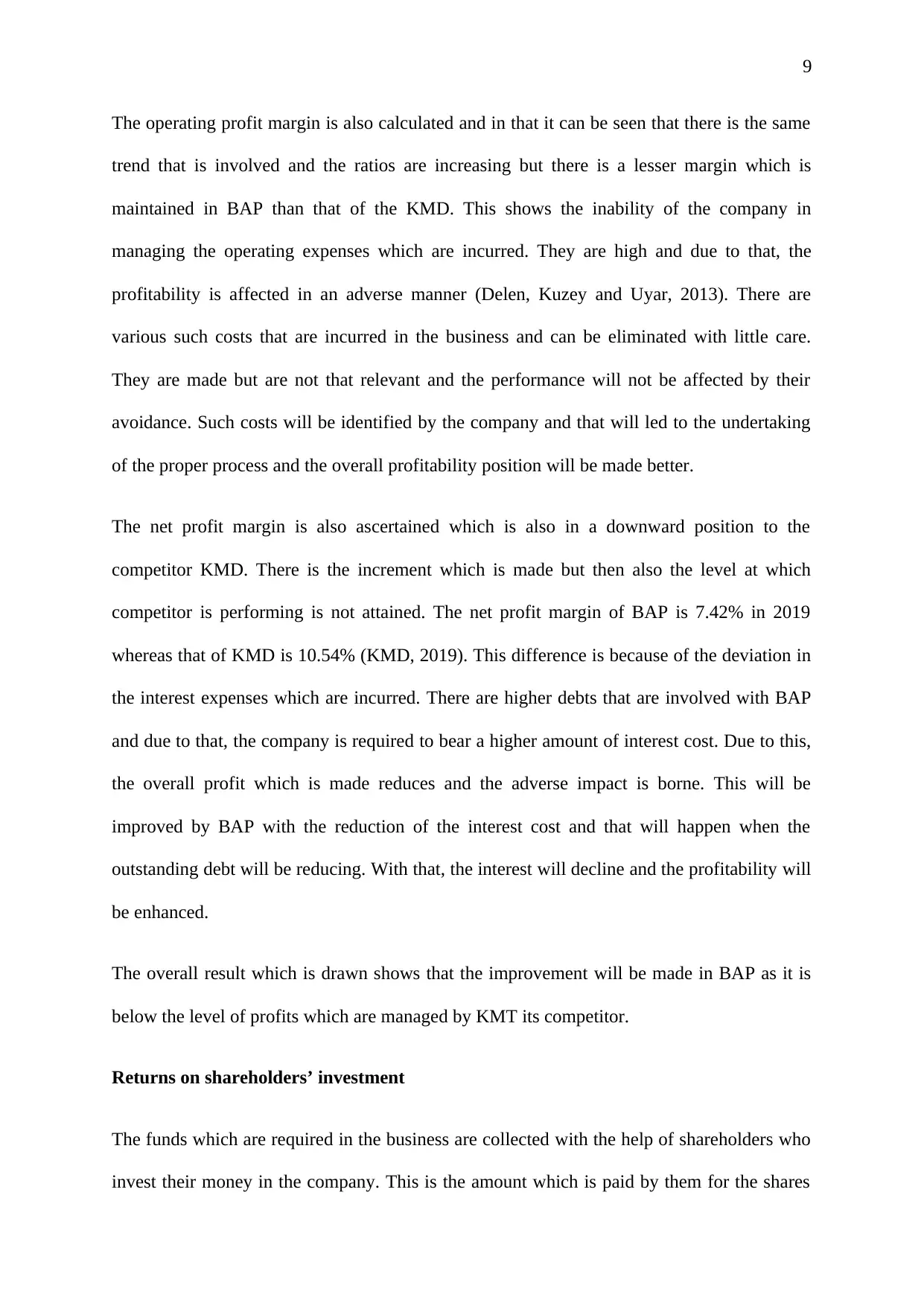
9
The operating profit margin is also calculated and in that it can be seen that there is the same
trend that is involved and the ratios are increasing but there is a lesser margin which is
maintained in BAP than that of the KMD. This shows the inability of the company in
managing the operating expenses which are incurred. They are high and due to that, the
profitability is affected in an adverse manner (Delen, Kuzey and Uyar, 2013). There are
various such costs that are incurred in the business and can be eliminated with little care.
They are made but are not that relevant and the performance will not be affected by their
avoidance. Such costs will be identified by the company and that will led to the undertaking
of the proper process and the overall profitability position will be made better.
The net profit margin is also ascertained which is also in a downward position to the
competitor KMD. There is the increment which is made but then also the level at which
competitor is performing is not attained. The net profit margin of BAP is 7.42% in 2019
whereas that of KMD is 10.54% (KMD, 2019). This difference is because of the deviation in
the interest expenses which are incurred. There are higher debts that are involved with BAP
and due to that, the company is required to bear a higher amount of interest cost. Due to this,
the overall profit which is made reduces and the adverse impact is borne. This will be
improved by BAP with the reduction of the interest cost and that will happen when the
outstanding debt will be reducing. With that, the interest will decline and the profitability will
be enhanced.
The overall result which is drawn shows that the improvement will be made in BAP as it is
below the level of profits which are managed by KMT its competitor.
Returns on shareholders’ investment
The funds which are required in the business are collected with the help of shareholders who
invest their money in the company. This is the amount which is paid by them for the shares
The operating profit margin is also calculated and in that it can be seen that there is the same
trend that is involved and the ratios are increasing but there is a lesser margin which is
maintained in BAP than that of the KMD. This shows the inability of the company in
managing the operating expenses which are incurred. They are high and due to that, the
profitability is affected in an adverse manner (Delen, Kuzey and Uyar, 2013). There are
various such costs that are incurred in the business and can be eliminated with little care.
They are made but are not that relevant and the performance will not be affected by their
avoidance. Such costs will be identified by the company and that will led to the undertaking
of the proper process and the overall profitability position will be made better.
The net profit margin is also ascertained which is also in a downward position to the
competitor KMD. There is the increment which is made but then also the level at which
competitor is performing is not attained. The net profit margin of BAP is 7.42% in 2019
whereas that of KMD is 10.54% (KMD, 2019). This difference is because of the deviation in
the interest expenses which are incurred. There are higher debts that are involved with BAP
and due to that, the company is required to bear a higher amount of interest cost. Due to this,
the overall profit which is made reduces and the adverse impact is borne. This will be
improved by BAP with the reduction of the interest cost and that will happen when the
outstanding debt will be reducing. With that, the interest will decline and the profitability will
be enhanced.
The overall result which is drawn shows that the improvement will be made in BAP as it is
below the level of profits which are managed by KMT its competitor.
Returns on shareholders’ investment
The funds which are required in the business are collected with the help of shareholders who
invest their money in the company. This is the amount which is paid by them for the shares
⊘ This is a preview!⊘
Do you want full access?
Subscribe today to unlock all pages.

Trusted by 1+ million students worldwide
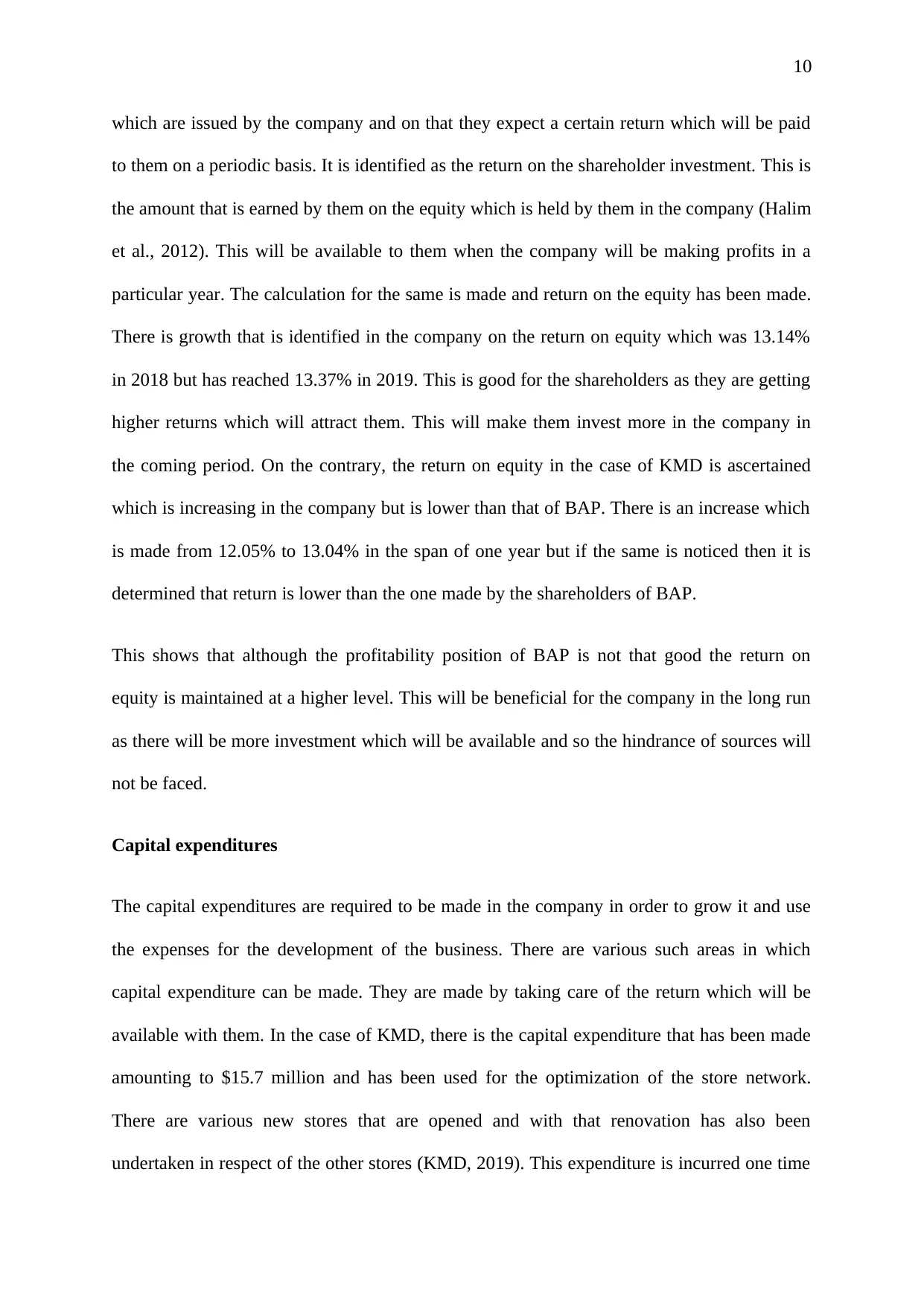
10
which are issued by the company and on that they expect a certain return which will be paid
to them on a periodic basis. It is identified as the return on the shareholder investment. This is
the amount that is earned by them on the equity which is held by them in the company (Halim
et al., 2012). This will be available to them when the company will be making profits in a
particular year. The calculation for the same is made and return on the equity has been made.
There is growth that is identified in the company on the return on equity which was 13.14%
in 2018 but has reached 13.37% in 2019. This is good for the shareholders as they are getting
higher returns which will attract them. This will make them invest more in the company in
the coming period. On the contrary, the return on equity in the case of KMD is ascertained
which is increasing in the company but is lower than that of BAP. There is an increase which
is made from 12.05% to 13.04% in the span of one year but if the same is noticed then it is
determined that return is lower than the one made by the shareholders of BAP.
This shows that although the profitability position of BAP is not that good the return on
equity is maintained at a higher level. This will be beneficial for the company in the long run
as there will be more investment which will be available and so the hindrance of sources will
not be faced.
Capital expenditures
The capital expenditures are required to be made in the company in order to grow it and use
the expenses for the development of the business. There are various such areas in which
capital expenditure can be made. They are made by taking care of the return which will be
available with them. In the case of KMD, there is the capital expenditure that has been made
amounting to $15.7 million and has been used for the optimization of the store network.
There are various new stores that are opened and with that renovation has also been
undertaken in respect of the other stores (KMD, 2019). This expenditure is incurred one time
which are issued by the company and on that they expect a certain return which will be paid
to them on a periodic basis. It is identified as the return on the shareholder investment. This is
the amount that is earned by them on the equity which is held by them in the company (Halim
et al., 2012). This will be available to them when the company will be making profits in a
particular year. The calculation for the same is made and return on the equity has been made.
There is growth that is identified in the company on the return on equity which was 13.14%
in 2018 but has reached 13.37% in 2019. This is good for the shareholders as they are getting
higher returns which will attract them. This will make them invest more in the company in
the coming period. On the contrary, the return on equity in the case of KMD is ascertained
which is increasing in the company but is lower than that of BAP. There is an increase which
is made from 12.05% to 13.04% in the span of one year but if the same is noticed then it is
determined that return is lower than the one made by the shareholders of BAP.
This shows that although the profitability position of BAP is not that good the return on
equity is maintained at a higher level. This will be beneficial for the company in the long run
as there will be more investment which will be available and so the hindrance of sources will
not be faced.
Capital expenditures
The capital expenditures are required to be made in the company in order to grow it and use
the expenses for the development of the business. There are various such areas in which
capital expenditure can be made. They are made by taking care of the return which will be
available with them. In the case of KMD, there is the capital expenditure that has been made
amounting to $15.7 million and has been used for the optimization of the store network.
There are various new stores that are opened and with that renovation has also been
undertaken in respect of the other stores (KMD, 2019). This expenditure is incurred one time
Paraphrase This Document
Need a fresh take? Get an instant paraphrase of this document with our AI Paraphraser
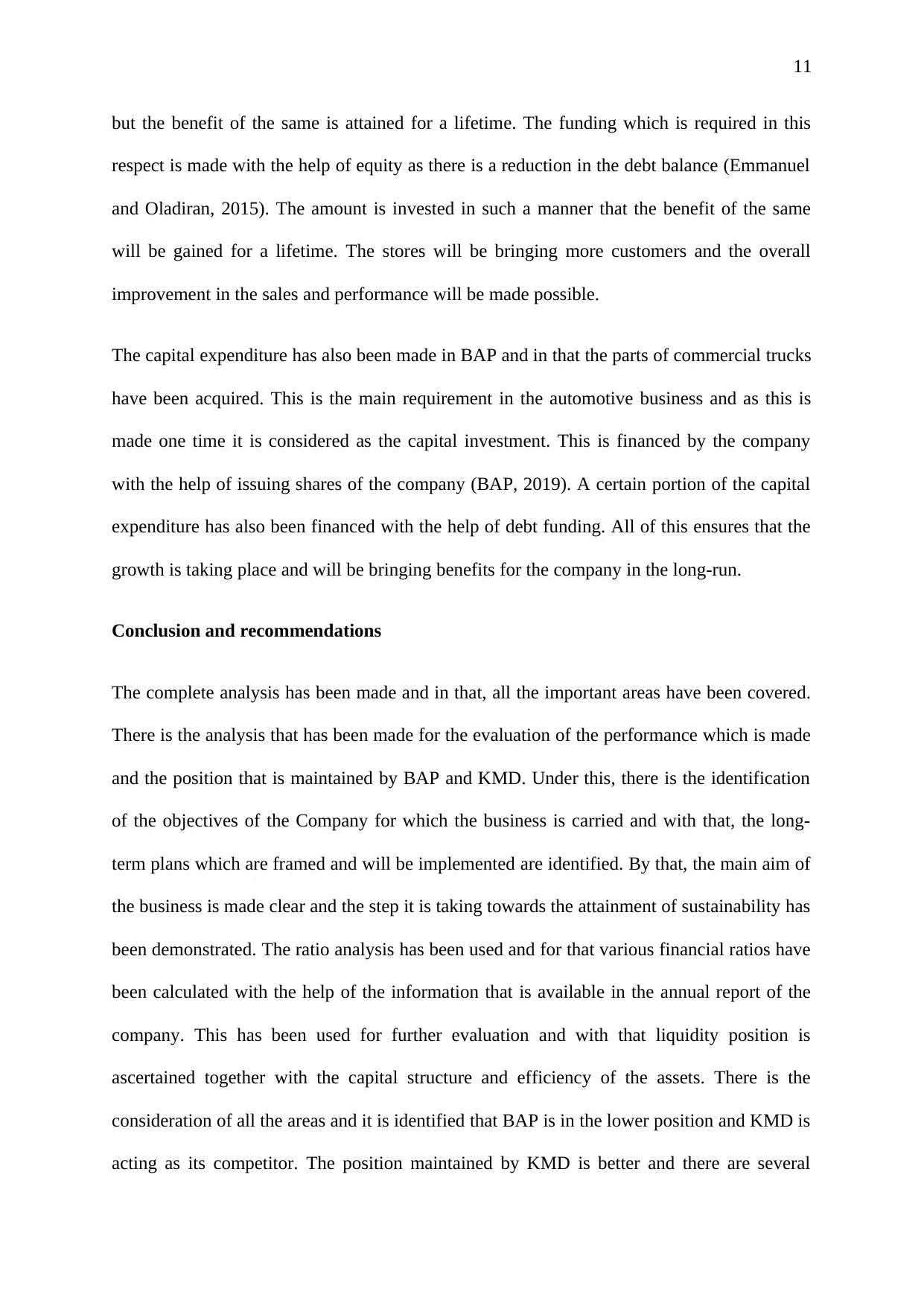
11
but the benefit of the same is attained for a lifetime. The funding which is required in this
respect is made with the help of equity as there is a reduction in the debt balance (Emmanuel
and Oladiran, 2015). The amount is invested in such a manner that the benefit of the same
will be gained for a lifetime. The stores will be bringing more customers and the overall
improvement in the sales and performance will be made possible.
The capital expenditure has also been made in BAP and in that the parts of commercial trucks
have been acquired. This is the main requirement in the automotive business and as this is
made one time it is considered as the capital investment. This is financed by the company
with the help of issuing shares of the company (BAP, 2019). A certain portion of the capital
expenditure has also been financed with the help of debt funding. All of this ensures that the
growth is taking place and will be bringing benefits for the company in the long-run.
Conclusion and recommendations
The complete analysis has been made and in that, all the important areas have been covered.
There is the analysis that has been made for the evaluation of the performance which is made
and the position that is maintained by BAP and KMD. Under this, there is the identification
of the objectives of the Company for which the business is carried and with that, the long-
term plans which are framed and will be implemented are identified. By that, the main aim of
the business is made clear and the step it is taking towards the attainment of sustainability has
been demonstrated. The ratio analysis has been used and for that various financial ratios have
been calculated with the help of the information that is available in the annual report of the
company. This has been used for further evaluation and with that liquidity position is
ascertained together with the capital structure and efficiency of the assets. There is the
consideration of all the areas and it is identified that BAP is in the lower position and KMD is
acting as its competitor. The position maintained by KMD is better and there are several
but the benefit of the same is attained for a lifetime. The funding which is required in this
respect is made with the help of equity as there is a reduction in the debt balance (Emmanuel
and Oladiran, 2015). The amount is invested in such a manner that the benefit of the same
will be gained for a lifetime. The stores will be bringing more customers and the overall
improvement in the sales and performance will be made possible.
The capital expenditure has also been made in BAP and in that the parts of commercial trucks
have been acquired. This is the main requirement in the automotive business and as this is
made one time it is considered as the capital investment. This is financed by the company
with the help of issuing shares of the company (BAP, 2019). A certain portion of the capital
expenditure has also been financed with the help of debt funding. All of this ensures that the
growth is taking place and will be bringing benefits for the company in the long-run.
Conclusion and recommendations
The complete analysis has been made and in that, all the important areas have been covered.
There is the analysis that has been made for the evaluation of the performance which is made
and the position that is maintained by BAP and KMD. Under this, there is the identification
of the objectives of the Company for which the business is carried and with that, the long-
term plans which are framed and will be implemented are identified. By that, the main aim of
the business is made clear and the step it is taking towards the attainment of sustainability has
been demonstrated. The ratio analysis has been used and for that various financial ratios have
been calculated with the help of the information that is available in the annual report of the
company. This has been used for further evaluation and with that liquidity position is
ascertained together with the capital structure and efficiency of the assets. There is the
consideration of all the areas and it is identified that BAP is in the lower position and KMD is
acting as its competitor. The position maintained by KMD is better and there are several
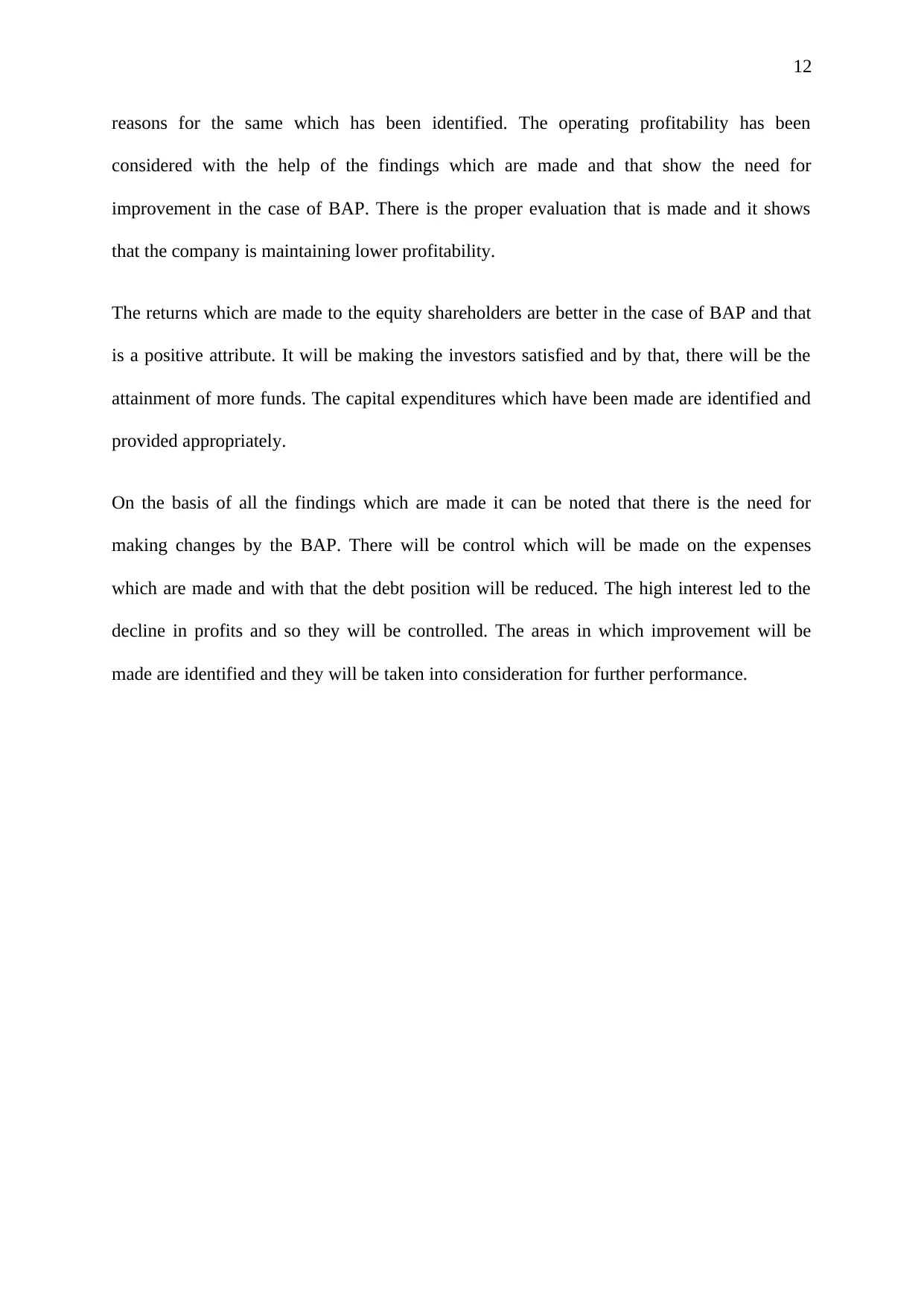
12
reasons for the same which has been identified. The operating profitability has been
considered with the help of the findings which are made and that show the need for
improvement in the case of BAP. There is the proper evaluation that is made and it shows
that the company is maintaining lower profitability.
The returns which are made to the equity shareholders are better in the case of BAP and that
is a positive attribute. It will be making the investors satisfied and by that, there will be the
attainment of more funds. The capital expenditures which have been made are identified and
provided appropriately.
On the basis of all the findings which are made it can be noted that there is the need for
making changes by the BAP. There will be control which will be made on the expenses
which are made and with that the debt position will be reduced. The high interest led to the
decline in profits and so they will be controlled. The areas in which improvement will be
made are identified and they will be taken into consideration for further performance.
reasons for the same which has been identified. The operating profitability has been
considered with the help of the findings which are made and that show the need for
improvement in the case of BAP. There is the proper evaluation that is made and it shows
that the company is maintaining lower profitability.
The returns which are made to the equity shareholders are better in the case of BAP and that
is a positive attribute. It will be making the investors satisfied and by that, there will be the
attainment of more funds. The capital expenditures which have been made are identified and
provided appropriately.
On the basis of all the findings which are made it can be noted that there is the need for
making changes by the BAP. There will be control which will be made on the expenses
which are made and with that the debt position will be reduced. The high interest led to the
decline in profits and so they will be controlled. The areas in which improvement will be
made are identified and they will be taken into consideration for further performance.
⊘ This is a preview!⊘
Do you want full access?
Subscribe today to unlock all pages.

Trusted by 1+ million students worldwide
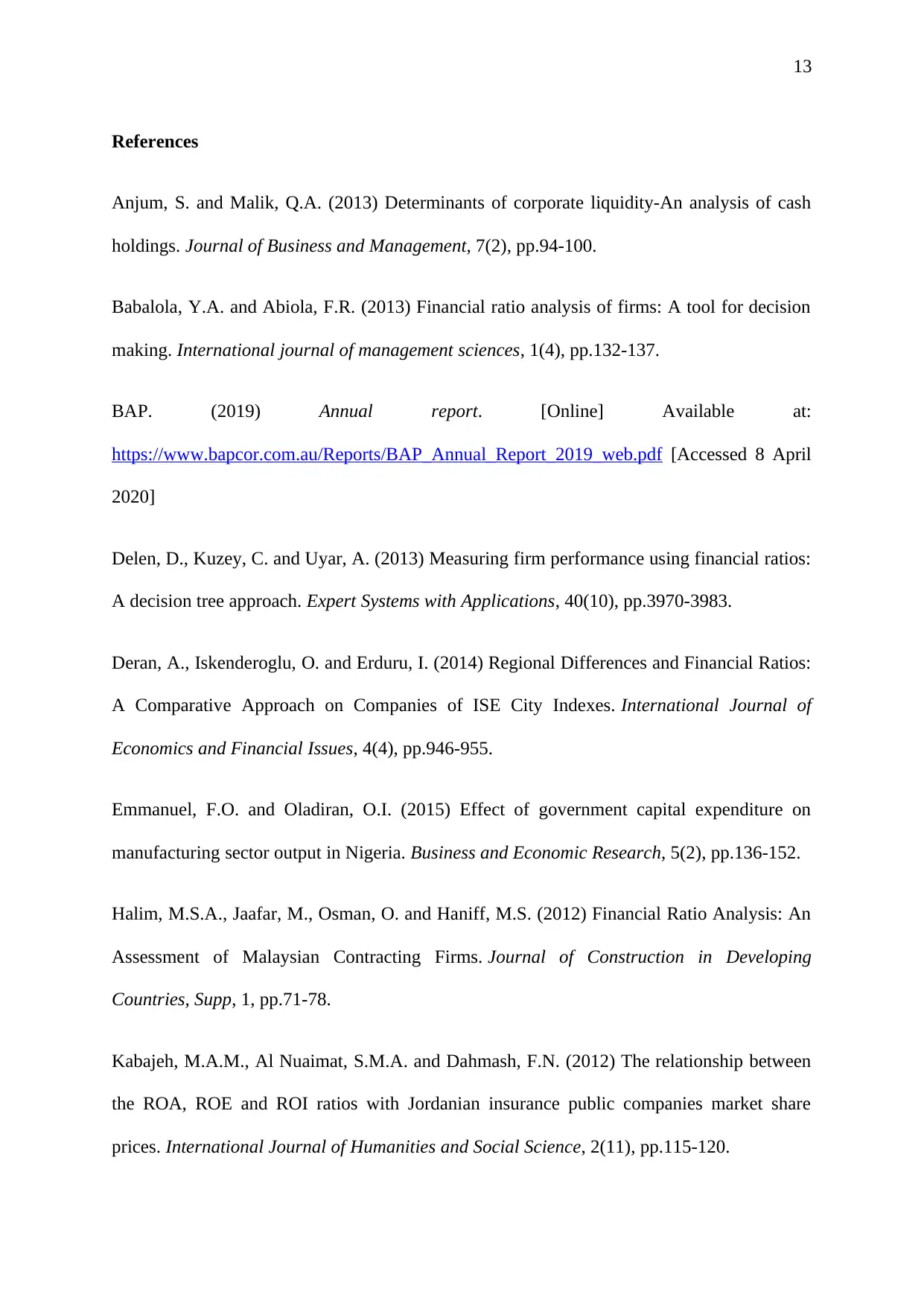
13
References
Anjum, S. and Malik, Q.A. (2013) Determinants of corporate liquidity-An analysis of cash
holdings. Journal of Business and Management, 7(2), pp.94-100.
Babalola, Y.A. and Abiola, F.R. (2013) Financial ratio analysis of firms: A tool for decision
making. International journal of management sciences, 1(4), pp.132-137.
BAP. (2019) Annual report. [Online] Available at:
https://www.bapcor.com.au/Reports/BAP_Annual_Report_2019_web.pdf [Accessed 8 April
2020]
Delen, D., Kuzey, C. and Uyar, A. (2013) Measuring firm performance using financial ratios:
A decision tree approach. Expert Systems with Applications, 40(10), pp.3970-3983.
Deran, A., Iskenderoglu, O. and Erduru, I. (2014) Regional Differences and Financial Ratios:
A Comparative Approach on Companies of ISE City Indexes. International Journal of
Economics and Financial Issues, 4(4), pp.946-955.
Emmanuel, F.O. and Oladiran, O.I. (2015) Effect of government capital expenditure on
manufacturing sector output in Nigeria. Business and Economic Research, 5(2), pp.136-152.
Halim, M.S.A., Jaafar, M., Osman, O. and Haniff, M.S. (2012) Financial Ratio Analysis: An
Assessment of Malaysian Contracting Firms. Journal of Construction in Developing
Countries, Supp, 1, pp.71-78.
Kabajeh, M.A.M., Al Nuaimat, S.M.A. and Dahmash, F.N. (2012) The relationship between
the ROA, ROE and ROI ratios with Jordanian insurance public companies market share
prices. International Journal of Humanities and Social Science, 2(11), pp.115-120.
References
Anjum, S. and Malik, Q.A. (2013) Determinants of corporate liquidity-An analysis of cash
holdings. Journal of Business and Management, 7(2), pp.94-100.
Babalola, Y.A. and Abiola, F.R. (2013) Financial ratio analysis of firms: A tool for decision
making. International journal of management sciences, 1(4), pp.132-137.
BAP. (2019) Annual report. [Online] Available at:
https://www.bapcor.com.au/Reports/BAP_Annual_Report_2019_web.pdf [Accessed 8 April
2020]
Delen, D., Kuzey, C. and Uyar, A. (2013) Measuring firm performance using financial ratios:
A decision tree approach. Expert Systems with Applications, 40(10), pp.3970-3983.
Deran, A., Iskenderoglu, O. and Erduru, I. (2014) Regional Differences and Financial Ratios:
A Comparative Approach on Companies of ISE City Indexes. International Journal of
Economics and Financial Issues, 4(4), pp.946-955.
Emmanuel, F.O. and Oladiran, O.I. (2015) Effect of government capital expenditure on
manufacturing sector output in Nigeria. Business and Economic Research, 5(2), pp.136-152.
Halim, M.S.A., Jaafar, M., Osman, O. and Haniff, M.S. (2012) Financial Ratio Analysis: An
Assessment of Malaysian Contracting Firms. Journal of Construction in Developing
Countries, Supp, 1, pp.71-78.
Kabajeh, M.A.M., Al Nuaimat, S.M.A. and Dahmash, F.N. (2012) The relationship between
the ROA, ROE and ROI ratios with Jordanian insurance public companies market share
prices. International Journal of Humanities and Social Science, 2(11), pp.115-120.
Paraphrase This Document
Need a fresh take? Get an instant paraphrase of this document with our AI Paraphraser
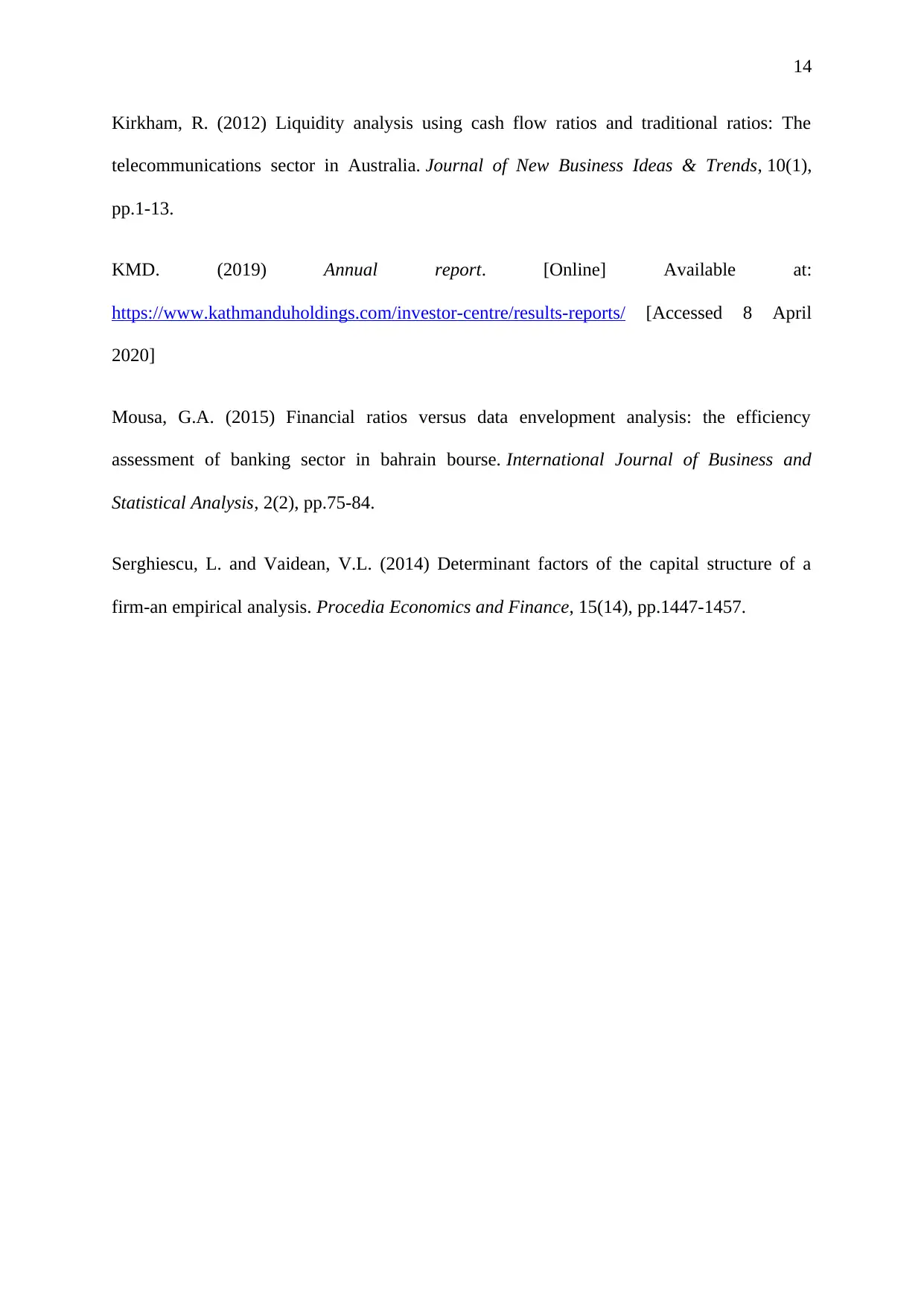
14
Kirkham, R. (2012) Liquidity analysis using cash flow ratios and traditional ratios: The
telecommunications sector in Australia. Journal of New Business Ideas & Trends, 10(1),
pp.1-13.
KMD. (2019) Annual report. [Online] Available at:
https://www.kathmanduholdings.com/investor-centre/results-reports/ [Accessed 8 April
2020]
Mousa, G.A. (2015) Financial ratios versus data envelopment analysis: the efficiency
assessment of banking sector in bahrain bourse. International Journal of Business and
Statistical Analysis, 2(2), pp.75-84.
Serghiescu, L. and Vaidean, V.L. (2014) Determinant factors of the capital structure of a
firm-an empirical analysis. Procedia Economics and Finance, 15(14), pp.1447-1457.
Kirkham, R. (2012) Liquidity analysis using cash flow ratios and traditional ratios: The
telecommunications sector in Australia. Journal of New Business Ideas & Trends, 10(1),
pp.1-13.
KMD. (2019) Annual report. [Online] Available at:
https://www.kathmanduholdings.com/investor-centre/results-reports/ [Accessed 8 April
2020]
Mousa, G.A. (2015) Financial ratios versus data envelopment analysis: the efficiency
assessment of banking sector in bahrain bourse. International Journal of Business and
Statistical Analysis, 2(2), pp.75-84.
Serghiescu, L. and Vaidean, V.L. (2014) Determinant factors of the capital structure of a
firm-an empirical analysis. Procedia Economics and Finance, 15(14), pp.1447-1457.

15
Appendix
Appendix
⊘ This is a preview!⊘
Do you want full access?
Subscribe today to unlock all pages.

Trusted by 1+ million students worldwide
1 out of 15
Related Documents
Your All-in-One AI-Powered Toolkit for Academic Success.
+13062052269
info@desklib.com
Available 24*7 on WhatsApp / Email
![[object Object]](/_next/static/media/star-bottom.7253800d.svg)
Unlock your academic potential
© 2024 | Zucol Services PVT LTD | All rights reserved.





